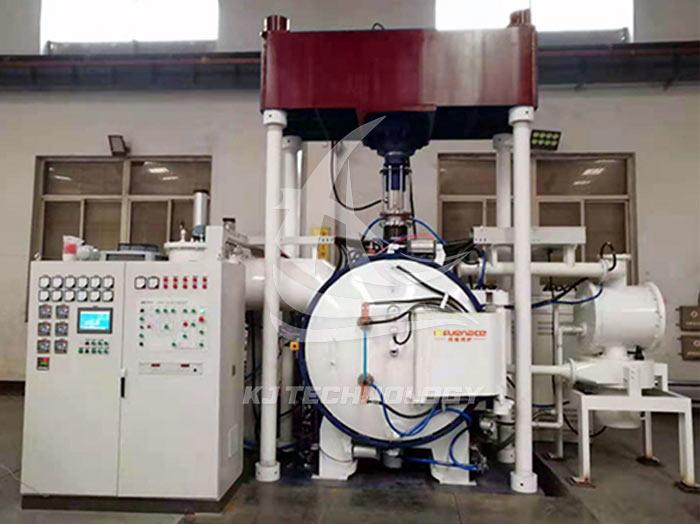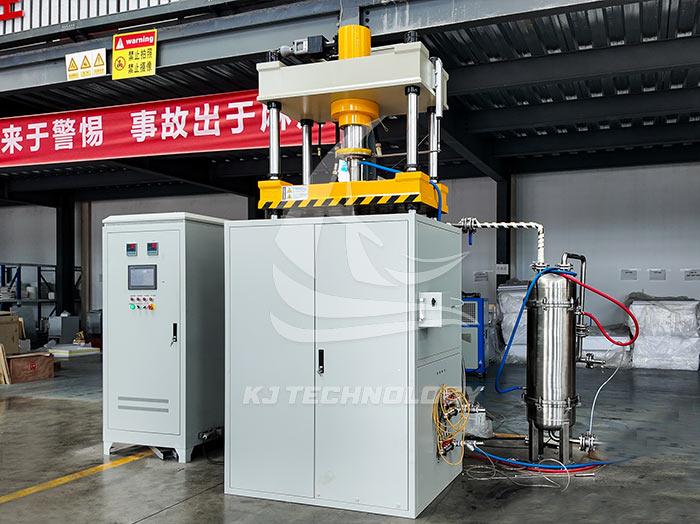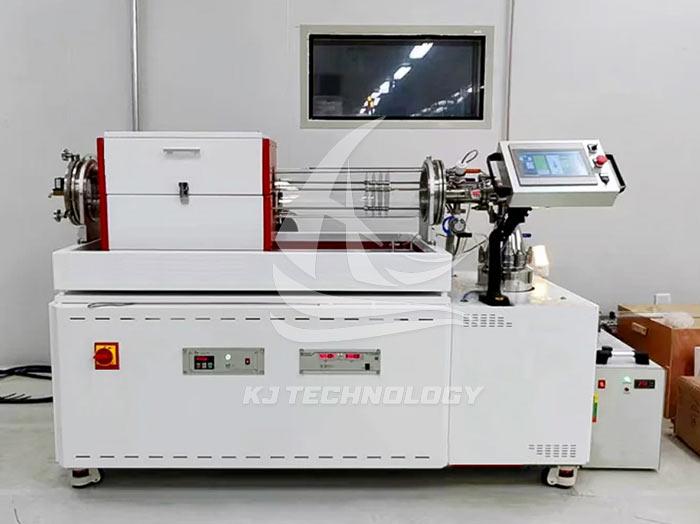What processes can a high vacuum and high temperature muffle furnace be used for?
 09-16-2025 Author: KJ technology
09-16-2025 Author: KJ technology
The high vacuum and high temperature muffle furnace combines high vacuum environment and high temperature processing capability, and can achieve precise process control in multiple fields. Its core process applications and advantages are as follows:
1. Material synthesis and modification: breaking through the limitations of conventional conditions
Preparation of nanomaterials
Vacuum environment inhibits agglomeration: calcining metal salt precursors (such as nitrates and acetates) under vacuum can avoid the reaction of nanoparticles with oxygen and water vapor to form an oxide layer, thereby obtaining highly dispersed nanoparticles. For example, when preparing nano titanium dioxide, the vacuum conditions can control the particle size within the range of 10-50 nanometers, and the distribution is uniform, significantly improving the photocatalytic activity.
High temperature promotes crystallization: By precisely controlling the heating rate (such as 5 ℃/min) and holding time (such as 2 hours), nanomaterials can be induced to form specific crystal forms (such as rutile and rutile), optimizing their physical and chemical properties.
Synthesis of High Temperature Superconducting Materials
Coordinated control of atmosphere and temperature: Heating the yttrium barium copper oxygen (YBCO) precursor to 900-950 ℃ in a vacuum or inert atmosphere (such as argon), and precisely controlling the oxygen partial pressure, can induce the formation of superconducting phases and obtain materials with critical transition temperatures (Tc) above 90K.
Reduce impurity phases: Vacuum environment can suppress the volatilization of metal elements (such as copper), avoid the formation of non superconducting phases (such as BaCuO ₂), and improve material purity.
Development of functional ceramics
Densification sintering: Sintering alumina ceramics in a vacuum environment of 1600-1800 ℃ can eliminate pores, increase density, and reduce dielectric loss, making it suitable for high-frequency electronic device substrates.
Preparation of Gradient Functional Materials (FGM): By controlling the vacuum degree and temperature in layers, gradient changes in the composition of ceramic materials can be achieved. For example, in thermal barrier coatings, a gradient structure from the metal substrate to the ceramic surface can be prepared to improve thermal shock resistance.
2. Metal Heat Treatment: Optimizing Organizational Structure and Properties
annealing
Eliminating internal stress: Vacuum annealing (600-700 ℃, holding for 2 hours) of cold worked titanium alloy can eliminate work hardening, restore plasticity, and avoid performance degradation caused by surface oxidation.
Grain refinement: By controlling the cooling rate (such as 10 ℃/min), recrystallization can be induced, resulting in finer grain size and improved material strength and toughness.
Vacuum quenching
High hardness and wear resistance: After heating tool steel to 1050 ℃ and rapidly cooling it in a vacuum environment (quenching medium is high-pressure nitrogen gas), a martensitic structure can be obtained, which is suitable for manufacturing high wear resistant parts such as cutting tools and molds.
Reduce deformation: Vacuum quenching can avoid deformation caused by uneven cooling of the medium in conventional quenching, and improve the dimensional accuracy of parts.
vacuum brazing
High strength connection: Heating to 800-900 ℃ in a vacuum environment, using silver based solder to connect ceramics and metals, can form metallurgical bonding, with a shear strength of over 100MPa, suitable for aerospace electronic packaging.
Avoid oxidation: Vacuum environment can prevent the oxidation of brazing material and base material, ensuring welding quality.
3. Ceramic and Glass Craftsmanship: Enhancing Product Performance and Reliability
Ceramic sintering
Preparation of transparent ceramics: Sintering alumina ceramics in a vacuum environment at 1800 ℃ can eliminate pores and impurities, obtaining transparent ceramics with a transmittance of over 85%, suitable for high-pressure sodium lamp tubes, infrared windows, etc.
Sintering of Multi Layer Ceramic Capacitors (MLCC): Vacuum sintering under nitrogen protection can avoid oxidation of the silver electrode, while controlling the sintering shrinkage rate to ensure the electrical performance and reliability of the capacitor.
Glass melting and annealing
Preparation of high-purity glass: Melting optical glass in a vacuum environment can avoid bubble and stripe defects, while reducing the content of heavy metal impurities (such as iron and copper), improving the transparency and chemical stability of the glass.
Glass annealing: By precisely controlling the cooling rate (such as 5 ℃/minute), internal stress in glass products can be eliminated, cracking can be prevented, and strength can be improved (bending strength can be enhanced).
4. Electronic component manufacturing: ensuring high performance and long lifespan
Ceramic capacitor sintering
Low temperature co fired ceramics (LTCC): Sintering silver palladium electrodes and ceramic dielectric layers in a vacuum environment at 850 ℃ can achieve multi-layer circuit integration, suitable for high-frequency communication modules (such as 5G base station filters).
High capacitance density: By optimizing the sintering process, the capacitance density can be increased to meet the needs of miniaturized electronic devices.
Production of magnetic materials
Pre firing of ferrite magnetic materials: Pre firing manganese zinc ferrite raw materials in a vacuum environment of 1000-1200 ℃ can promote solid-state reactions, form soft magnetic phases, improve magnetic permeability, and reduce losses.
Sintering densification: After vacuum sintering at 1300 ℃, the ferrite material has a higher density and stable magnetic properties, making it suitable for switching power transformers.
5. Environmental Protection and Resource Utilization: Achieving Green Production
Hazardous waste incineration
Medical waste disposal: Burning medical plastics, gauze, etc. in a vacuum environment at 1200 ℃ can completely decompose organic matter into CO ₂ and H ₂ O, while reducing the generation of dioxins, which meets environmental standards.
Heavy metal solidification: When incinerating waste containing heavy metals, a vacuum environment can promote the volatilization and condensation collection of heavy metals, avoiding secondary pollution.
Sludge pyrolysis
Resource utilization: Pyrolysis of sewage treatment sludge in a vacuum environment of 500-700 ℃ can convert it into combustible gases, bio oil, and carbon black, achieving sludge reduction and resource utilization.
Reducing pollutant emissions: Vacuum pyrolysis can suppress the generation of dioxins and furans, while avoiding the volatilization of heavy metals, resulting in significant environmental benefits.








